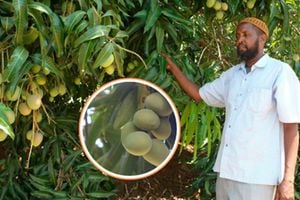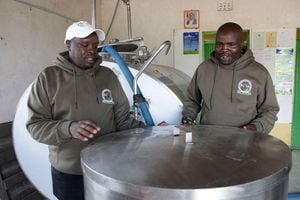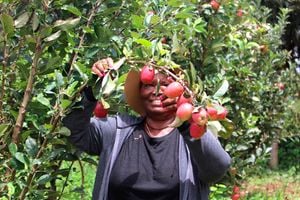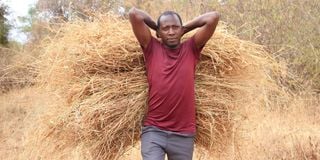
Benjamin Muthama with a bundle of pasture grass in Mikameni Village, Makueni County.
Two giant racks with bundles of grass greet visitors at Benjamin Muthama’s Mikameni village homestead in Makueni County.
This is replicated in every homestead in the countryside where the sun burns fiercely as locals are abandoning the growing maize, the region’s staple, in favour of pasture grass.
The animal expert is the face of an emerging group of farmers growing grass.
“You can’t find granaries in this village anymore. We cannot grow maize because rains have become unpredictable. Hay racks have replaced granaries,” Muthama says.
With six acres exclusively for grass, Muthama stands out in the village where many families dedicate small portions to pasture.
The rest is usually reserved for drought-resistant crops like cowpeas, dolichos, mung beans and sorghum.
The African fox tail – locally known as Ndatakivumbu – and Maasai love or Mbwea, are the common grass varieties in Mikameni.
The grasses are known for protein and fibre respectfully.
The entrepreneurship bug hit Muthama in 2019, when he graduated from Jaramogi Oginga Odinga University, Bondo.
He took to the village when everyone expected him to go to town and look for a white-collar job.
Muthama has been an inspiration to many young people. Most of the grass ends up in the market where a bale fetches up to Sh400.
The enterprise has enabled Muthama to expand land under the grass. He has also set up an agrovet in Kiteei township and bought three dairy cows, which produce 30 and 40 litres of milk daily.
The long drought a year ago also fuelled the grass enterprise.
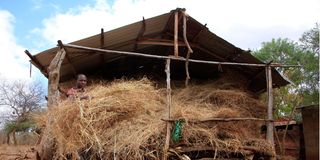
Benjamin Muthama arranges grass in a hay rack in Mikameni Village, Makueni County.
“We saw the light when hundreds of pastoralists from Kajiado County began driving their animals to Makueni in search of grass in 2022,” he says.
Kitise Chief Patrick Muange says some families made up to Sh60,000 a day for allowing the cattle to graze on their land.
“We became convinced that grass is gold,” says the administrator, who is among those growing pasture grass.
Kitise Rural Development Organisation, a CBO, is credited with the grass revolution in one of the most dry regions in Kenya.
It introduced grass farming as a way of stopping soil erosion. In addition to promoting the growing of grass for domestic and commercial purposes, the CBO encourages locals to store pasture to be used in bad days.
With this, milk production has been on a steady increase. The organisation also buys hay and stores it in three giant silos in Kitise. The silos can store up to 10,000 bales.
“We have established networks in Kajiado, Kitui, Machakos and Tharaka Nithi counties,” says Serah Mutiso, a manager at the CBO.
The grass enterprise has caught the attention of the Warehouse Receipt Council (WRC), a state agency linked with the Ministry of Trade and Investment.
At a recent meeting with top Makueni County government officials, farmers, cooperatives, traders and financial institutions, a team from the WRC announced a plan by the government to include emerging commodities like pasture grass in the Warehouse Receipt System.
The system encourages aggregation and trading in commodities like maize, pulses, potatoes and green grams. It enables farmers to avoid the low prices associated with glut while at the same time making them boost their production by accessing affordable loans against receipts issued by licensed warehouses.
“Storing produce in modern warehouses enhances value. A farmer who has stored produce in a licensed warehouse can access loans,” says Leonard Mwashuma, the head of Certification and Compliance at WRC.
Makueni Agriculture Executive Joyce Mutua says mung bean and grass farmers would reap more from their efforts if the plan by the government to onboard the commodities into the Warehouse Receipt System bears fruit.

